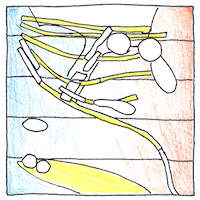Henrietta Swan Leavitt, Harlow Shapley, Edwin Hubble, Walter Baade
astronomy

|
The universe
Stars come in all sizes, so the brightness of a star alone tells us nothing about how far away it is. Henrietta Swan Leavitt studied photographic plates of 1777 stars in the Magellanic Clouds whose brightness varied regularly, called cepheid variable stars. Assuming they were all about the same distance from us, Leavitt discovered that brigher ones had longer periods; in fact, she found that the logarithms of their periods is directly related to their brightnesses. Leavitt’s discovery let Harlow Shapley use the periods and brightnesses of cepheids to measure the size of our galaxy, the Milky Way, and to locate our solar system in the galaxy. The big debate was whether spiral nebulae were inside the Milky Way or were similar in size as the Milky Way but very far away. This debate was settled when Edwin Hubble discovered cepheids in the Andromeda Galaxy, since their periods and brightnesses let him determine how far away they were. Walter Baade was the first to recognize different types of cepheids, some younger and brighter, and some older and less bright, which helped him double Hubble’s estimate for the size of the universe.
Cepheids
The cepheid stars are named after the star Delta Cephei in the constellation Cepheus identified by John Goodricke in 1784. Delta Cephei is in the Milky Way about thirteen hundred light-years from us, the Milky Way being a hundred thousand light-years in diameter. The Milky Way has under four hundred billion stars. The observable universe has over ten sextillion stars. Obviously we don’t have names for them all.
Standard candles
The mind is a candle that burns over many years, determining the size, the distance, and the importance of everything in its narrow scope. But it’s often wrong. Unacceptable events disturb it; contrary evidence confuses it; self-calibration is difficult. When a window opens it flickers in the wind. Useless in the sunlight; better than nothing in the dark.



The span between us and the oldest and most distant observable objects in the universe might be only a fraction of what lies beyond, unless you assume that no space exists beyond our cosmic horizon. But even comparing ourselves to the observable universe, whose edge is perhaps under 47 billion light years from us, makes us very very small.
See also in The book of science:
Readings in wikipedia:
Other readings: